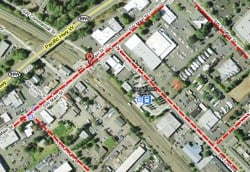
On June 23th, Tigard City Council voted unanimously in favor of planning code amendments that remove the city’s requirement to have bike lanes on specific downtown streets. Along with that decision, they also voted on a code amendment that allows them to put on-street motor vehicle parking on those streets where it was previously not permitted.
Prior to the vote, Tigard’s Transportation System Plan stated, as per their Bicycle Master Plan, that all arterial and collector streets should have a bike lane. The amended code now reads, “…with the exception of collectors within the downtown urban renewal district.”
In a statement released today, the Bicycle Transportation Alliance (BTA) said they are “concerned” about the Council’s decision and the Washington County Bicycle Transportation Coalition (WashCoBTC) emailed the City expressing their opposition.
“We are very concerned about the provision that removes the requirement for bicycle lanes on these streets.”
— From a statement by the BTA
Their are four streets in Tigard that will be impacted by this ruling: Main, Burnham, Scoffins, and Ash (view area in Google Map). According to the new code amendments, the City will now be able to put on-street vehicle parking on those streets and the installation of bike lanes will be up to the discretion of the City Engineer.
According to Tigard city planners, the reason for the changes is to give them more flexibility in downtown street design. Tigard is looking to revitalizing their downtown district and they feel streets in this district should not be governed by a blanket code that applies city-wide.
In their “Staff Analysis” of the proposal sent to the Planning Commission, Tigard staff wrote (download full ordinance and City Council order as PDF here):
“… Development Code street standards address collectors on a city-wide basis Little consideration was given on how collectors might function in different areas of the city. In this case, downtown collectors serve not only as connectors between arterials… they also transport users to a destination — Downtown Tigard.
…downtown collectors should also accommodate those wishing to spend time within the downtown by providing public parking options on the streets. On-street parking will be essential as the downtown redevelops to its intended dense form.”

Dick Bewersdorff
Tigard’s Planning Manager, Dick Bewersdorff told me today that the new code is focused on improving downtown. He does not see the decision as having a negative impact on bicycling. According to Bewersdorff, the addition of parked cars will calm traffic and the absence of a bike lane simply means that bikes can share the road with (now slower moving, in theory) cars.
“What we needed to have was parking as much as anything,” said Bewersdorff, “rather than freeways through the city.” Bewersdorff sees the code changes as an essential part of creating a vibrant “small town downtown center,” and told me that downtown Portland streets have similar configurations (he’s right, they do and because signals are timed for 10-12 mph, the work well as bike streets for confident riders).
“You can’t build streets that have parking, bike lanes, trees, are pedestrian friendly, etc… you don’t have much space. It’s a balancing act.”
— Dick Bewersdorff, City of Tigard Planning Manager
Bewersdorff said with limited roadway space and competing interests, there are always trade-off; “You can’t build streets that have parking, bike lanes, trees, are pedestrian friendly, etc… you don’t have much space. It’s a balancing act.”
When I asked him whether or not he feels the new code changes make downtown Tigard less appealing for people on bikes, he said, “I don’t think so, a lot of our staff members ride their bikes to and from city hall all the time, including some of the people involved in the decision.”
Director of the WashCoBTC Hall Ballard said their opposition was based on fears that these code changes would set a precedent for excluding bike facilities in future planning. But, he added, that if the decision went through (which it did) he would want the lanes to be wide enough for bikes and cars to share side by side.
Ballard feels that bikes fare best when they use the road like motor vehicles (as opposed to being in a bike lane). “When the city does any planning,” he added, “we’ll make sure the lanes are wide enough for bikes and cars.”
As for the addition of on-street parking. “I didn’t like that idea at all,” said Ballard. “The businesses are the ones that are shouting the most… we didn’t want to see that happen,” he added.
Ballard lamented that Tigard does not have an official Bike Advisory Committee and that his organization isn’t yet powerful enough to have a strong voice on these issues.
The BTA, which has over 5,000 members and represents all of Oregon, issued a prepared statement. Here it is in its entirety:
“We are very concerned about the provision that removes the requirement for bicycle lanes on these streets. We’re speaking with Tigard planners and elected officials to learn more about their plan for bicycle circulation downtown given this action, and we’re also analyzing potential legal implications of the decision.”
As for legal implications, the BTA is likely referring to the Bicycle Bill that states any major road project must include bike facilities. However, since these collector streets are city of Tigard property, not the state of Oregon’s, Bewersdorff says the Bicycle Bill does not apply.
— Download the full text of the ordinance as passed by Tigard City Council here (PDF).

